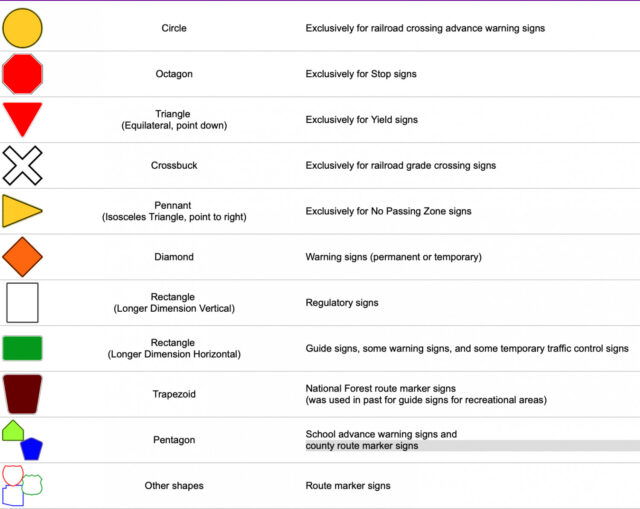“Signs convey information to travelers not only by their messages and color, but through their shape as well. Special shapes are specifically assigned to certain types of signs so that travelers can recognize them quickly and react appropriately. In general, the greater number of sides on a sign, the more critical a message it conveys” (http://www.trafficsign.us/signshape.html).[1]
In the traffic signs pictured, safety is regulated so that drivers can anticipate the road ahead. Likewise, flow of writing for a literature synthesis is controlled by the shape of the discourse, which can be manipulated by three variables: (a) meta structure (shape), (b) headings, and (c) transition devices. Their influences are increasingly more specific moving through these devices.
At the macro level, shape can be considered as a funnel (moving from broad to specific) or inverted funnel (specific to broad). The shape can also be chronological, beginning with the earliest and ending with the most recent references. The shape of a literature synthesis may also be methodological, in which similarities and differences are highlighted in the manner that previous research has been conducted. A feature of WRN is the use of supplemental materials that can be distributed to guide the writing process, using advance organizers or links to important websites. Shapes are operationalized in a slightly more specific manner using graphic organizers. For example, in Training Module 3[2] (pages 35-43), a number of structural devices (graphic organizers) are used to control the flow of information, which can then be used to articulate headings (in various nested levels. The heading structure of APA Guidelines is more than a list of style guides for capitalizing and indenting; rather, they control the logic of an argument, with outermost levels serving as primary warrants that are further articulated with nested headings. And if the language is sufficiently detailed, headings can serve as shorthand for speed reading the content and relations among topics. Finally, shape is enhanced by strategic use of transition devices within and across paragraphs. Given the primary genre of thesis and dissertation writing is argumentative, a number of obvious transition devices are available, which are addressed in another blog on Box Car Writing.
Moral of this blog: Writing can be controlled in three ways that work together: (a) overall structure that provides shape (which can be planned ahead and then simply invoked), (b) headings that provide obvious visual structures much like road signs, and (c) transition devices that deploy specific words for pivot and pirouette.
[1] All text and images on this page © Richard C. Moeur. All rights reserved.
[2] Tindal, G., Nolet, V., & Blake, G. (1992). Training Module 3: Focus on teaching and learning in content areas. Eugene, OR: University of Oregon: Behavioral Research and Teaching.

